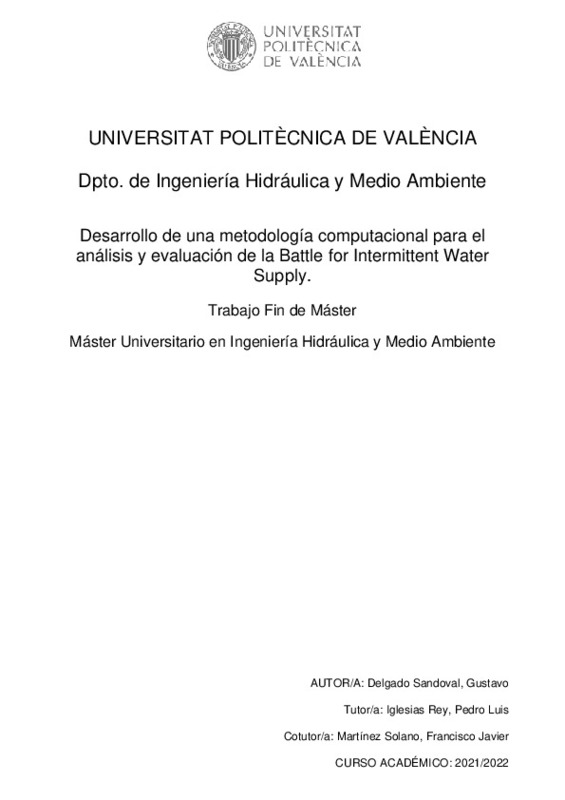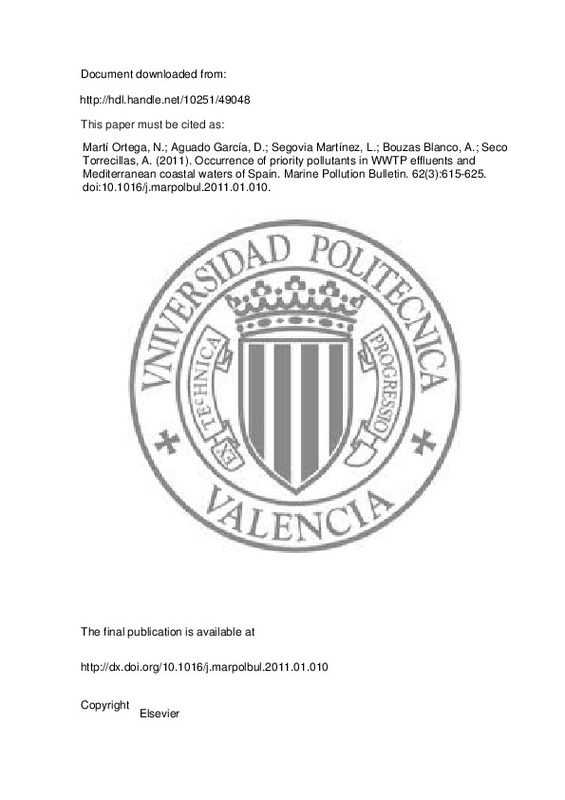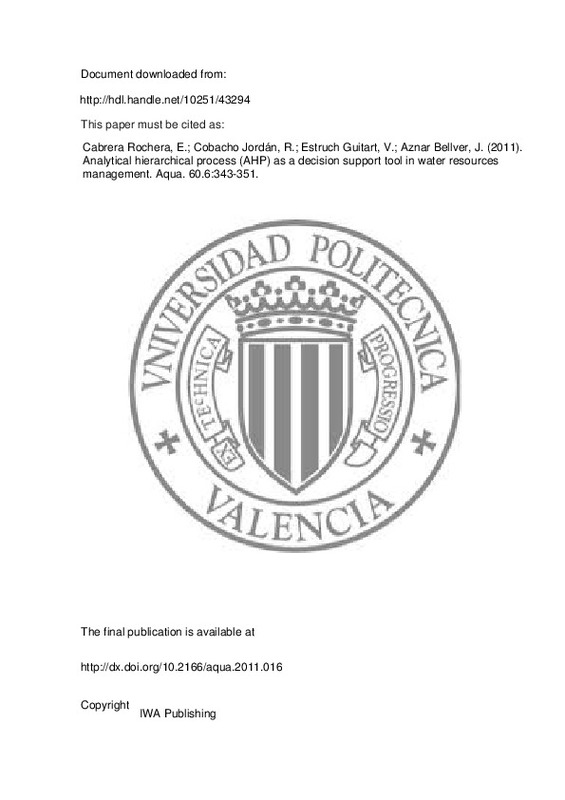JavaScript is disabled for your browser. Some features of this site may not work without it.
Buscar en RiuNet
Listar
Mi cuenta
Estadísticas
Ayuda RiuNet
Admin. UPV
Desarrollo de una metodología para el análisis y evaluación de la Battle of Intermittent Water Supply
Mostrar el registro sencillo del ítem
Ficheros en el ítem
| dc.contributor.advisor | Iglesias Rey, Pedro Luis
|
es_ES |
| dc.contributor.advisor | Martínez Solano, Francisco Javier
|
es_ES |
| dc.contributor.author | Delgado Sandoval, Gustavo Alonso
|
es_ES |
| dc.date.accessioned | 2022-11-29T07:51:42Z | |
| dc.date.available | 2022-11-29T07:51:42Z | |
| dc.date.created | 2022-09-22 | |
| dc.date.issued | 2022-11-29 | es_ES |
| dc.identifier.uri | http://hdl.handle.net/10251/190291 | |
| dc.description.abstract | [ES] En la mayoría de los países en vías de desarrollo de América Latina, los servicios de agua potable son deficientes por diversos motivos. Uno de ellos es el suministro intermitente. Este modo de operación no garantiza la calidad del agua y genera una repartición inequitativa del caudal y la presión a los usuarios. Por este motivo, uno de los intereses, es plantear estrategias o metodologías que permitan mejorar los sistemas con suministro intermitente o revertirlos a sistemas de suministro continuo. Con motivo de la 2nd International Conference on Water Distribution System Analysis & Computing and Control in the Water Industry, se va a celebrar la ¿Batte of the Intermittent Water Supply¿. Esta es la Novena edición de la serie de resolución de problemas de redes que comenzaron en 1985. Las ediciones anteriores tuvieron como objetivo diferentes temáticas como la optimización de la red, ubicación de sensores de calidad del agua y calibración de una red de abastecimiento. En esta ocasión, el desafío del 9th Battle Competition es encontrar la mejor solución para revertir la situación de una red de suministro intermitente a suministro continuo con una cantidad de agua disponible limitada. Una red modelo en EPANET será el punto de partida de la batalla. Habrá una lista de fugas identificadas que se proporcionarán como datos iniciales. El problema supone un abastecimiento de la demanda a través de aljibes o depósitos domiciliarios de techo o a nivel del suelo. Si bien es cierto que, revertir un sistema intermitente a uno continuo es un problema complejo, la batalla se enfoca en las mejoras de infraestructura de la red. Para ello, se dispone de un cierto presupuesto para invertir anualmente, durante un periodo de cinco años. Entre las acciones de inversión a realizar son la detección y reparación de fugas, reemplazo de tuberías, instalación de nuevas válvulas, incremento de capacidad de tanques de almacenamiento, instalación de nuevos equipos de bombeo e instalación de inversores de frecuencia. Finalmente, el plan de acciones e inversiones tomados por los participantes serán evaluados a través de nueve indicadores clave cuya mejor solución será la que maximice la suma de todos estos indicadores. El objetivo de este documento es desarrollar una metodología para el análisis y evaluación del problema presentado en la Battle for Intemittent Water Supply. Para ello, se va a desarrollar una aplicación en Visual Basic Net en combinación con la Toolkit de Epanet v2.2 que permita adaptar diferentes soluciones presentadas por los participantes de la batalla. La evaluación de las soluciones se realizará en dos etapas; la primera evaluará si las soluciones presentadas por cada participante son válidas o no de acuerdo con las condiciones de la batalla; y la segunda, calcular los indicadores definidos en las instrucciones. En la primera etapa, dicha herramienta generará los seis archivos intermedios (*.inp) con el modelo de fugas planteado por el comité de la batalla y el plan de acciones e inversiones enviado por cada participante. Además, la herramienta realizará una simulación de cada año para verificar el cumplimiento de las condiciones. En la segunda etapa, se realizará el cálculo de los nueve indicadores y se hará una valoración de cada equipo participante. Finalmente, se realizará un análisis de cada una de las soluciones presentadas para estudiar la metodología y las estrategias utilizadas. | es_ES |
| dc.description.abstract | [EN] In most developing countries in Latin America, drinking water services are deficient for various reasons. One of them is intermittent supply. This mode of operation does not guarantee the quality of the water and generates an inequitable distribution of flow and pressure to users. For this reason, one of the interests is to propose strategies or methodologies to improve intermittent supply systems or revert them to continuous supply systems. On the occasion of the 2nd International Conference on Water Distribution System Analysis & Computing and Control in the Water Industry, the "Battle of the Intermittent Water Supply" will be held. This is the Ninth edition of the network troubleshooting series that began in 1985. Previous editions had as their objective different topics such as network optimization, location of water quality sensors and calibration of a supply network. On this occasion, the challenge of the 9th Battle Competition is to find the best solution to reverse the situation from an intermittent red supply to a continuous supply with a limited amount of available water. A red model on EPANET will be the starting point of the battle. There will be a list of identified leaks that will be collected as initial data. The problem supposes a supply of the demand through cisterns or domiciliary deposits on the roof or at ground level. While it is true that reverting from intermittent to continuous is a complex problem, the battle is focused on network infrastructure improvements. For this, a certain budget is available to invest annually, for a period of five years. Among the investment actions to be carried out are the detection and repair of leaks, replacement of pipes, installation of new valves, increase in the capacity of storage tanks, installation of new pumping equipment and installation of frequency inverters. Finally, the plan of actions and investments taken by the participants will be evaluated through nine key indicators whose best solution will be the one that maximizes the sum of all these indicators. The objective of this document is to develop a methodology for the analysis and evaluation of the problem presented in the Battle for Intermittent Water Supply. To do this, a tool will be developed in combination with the Epanet Toolkit v2.2 that allows adapting different solutions presented by the participants in the battle. The evaluation of the solutions will be carried out in two stages; the first will evaluate whether the solutions presented by each participant are valid or not according to the conditions of the battle; and the second, calculate the indicators defined in the instructions. In the first stage, this tool will generate the hydraulic model with the leak model proposed by the battle committee and the action and investment plan sent by each participant. In addition, the tool will perform a simulation of each year to verify compliance with the conditions. In the second stage, the calculation of the nine indicators will be carried out and an assessment of each participating team will be made. Finally, an analysis of each of the solutions presented was carried out to study the methodology and strategies used. | es_ES |
| dc.format.extent | 139 | es_ES |
| dc.language | Español | es_ES |
| dc.publisher | Universitat Politècnica de València | es_ES |
| dc.rights | Reserva de todos los derechos | es_ES |
| dc.subject | Sistemas de distribución de agua | es_ES |
| dc.subject | Water distribution systems | es_ES |
| dc.subject | Modelos hidráulicos | es_ES |
| dc.subject | Intermittent water supply | es_ES |
| dc.subject | Battle of Intermittent Water Supply (BIWS) | es_ES |
| dc.subject | Batalla de las redes de agua | es_ES |
| dc.subject | Suministro de agua Intermitente | es_ES |
| dc.subject | Epanet | es_ES |
| dc.subject | Battle of Water Networks | es_ES |
| dc.subject.classification | MECANICA DE FLUIDOS | es_ES |
| dc.subject.other | Máster Universitario en Ingeniería Hidráulica y Medio Ambiente-Màster Universitari en Enginyeria Hidràulica i Medi Ambient | es_ES |
| dc.title | Desarrollo de una metodología para el análisis y evaluación de la Battle of Intermittent Water Supply | es_ES |
| dc.title.alternative | Development of a methodology for the analysis and evaluation of the Battle for Intermittent Water Supply. | es_ES |
| dc.title.alternative | Desenvolupament d'una Metodologia per a l'Anàlisi i Avaluació de la Battle of Intermittent Water Supply. | es_ES |
| dc.type | Tesis de máster | es_ES |
| dc.rights.accessRights | Abierto | es_ES |
| dc.contributor.affiliation | Universitat Politècnica de València. Departamento de Ingeniería Hidráulica y Medio Ambiente - Departament d'Enginyeria Hidràulica i Medi Ambient | es_ES |
| dc.description.bibliographicCitation | Delgado Sandoval, GA. (2022). Desarrollo de una metodología para el análisis y evaluación de la Battle of Intermittent Water Supply. Universitat Politècnica de València. http://hdl.handle.net/10251/190291 | es_ES |
| dc.description.accrualMethod | TFGM | es_ES |
| dc.relation.pasarela | TFGM\152407 | es_ES |









